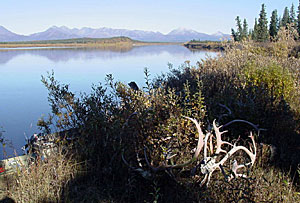Large areas of Alaska have no roads and few if any human-made structures. Vast expanses may look the same. This includes areas such as the northern boreal spruce forest and the tundra plains. Navigation is also difficult in mountains where inclement weather may further impair a hunter’s sense of direction. When visibility is poor, most humans lose their sense of direction. Even when visibility is good, the hills, valleys, and forests may confuse a hunter whose attention is concentrated on finding or tracking a game animal. Hunting in Alaska typically requires navigation skills to find your way to and from camp. Therefore, it is important to learn basic map and compass skills before venturing away from established roads, trails, and communities.
Topographic Map and Compass

Topographic map, GPS, survey tape and compass
Every hunter should carry the largest scale topographic maps available of the specific and surrounding area they will be hunting. A common scale map is 1 to 63,000, where one inch on paper represents one mile on the ground. These topographic maps are accurate and show details including elevation, types of land such as mountains, swamps, and forests, and any human structures. Topographic maps may be ordered from the
U.S. Geological Surveyor from businesses that offer services to backpackers, campers, and hunters.
Each person going afield should also carry a quality liquid-filled compass and know how to use it to lay out a base line and navigate to and from camp. A person skilled in map reading and compass use can safely navigate back to camp — even in fog, rain, or snow.
Global Positioning System (GPS)
An increasing number of hunters take a Global Positioning System with them to the hunting grounds. A GPS relies on a number of satellites to locate the user and report their position. A GPS is a very handy tool. The hunter can use the "way point" feature to mark the location of camp, and if successful in his or her pursuit of game, the location of the downed animal. The GPS can be used to navigate between these marked "way points." The "way point" feature can be especially valuable when a hunter must make multiple trips to pack out game meat. While the hunters are packing out meat, a bear may find the kill site and claim the meat. Using a GPS can help hunters be on high alert as they near their kill site, preventing a surprise confrontation with a bear. It is illegal in Alaska to kill a bear to keep it from eating your game animal.
Just like the map and compass, a GPS requires knowledge, practice, and experience to use correctly. Hunters must also remember that a GPS must be able to "see" the sky to locate the satellites. If you find yourself under trees in a Southeast Alaska forest or in a deep mountain canyon, the GPS may not work. Other considerations? A GPS unit operates on batteries that can go dead when you need them most. Also, a GPS and batteries are heavier and more expensive than map and compass. Simply put, bringing a GPS should not be viewed as a substitute for a good map, compass, and navigational skills.
You cannot master basic navigation skills by reading a book on the subject. Safe and responsible hunters can find assistance in mastering basic navigation skills by calling the Alaska Department of Fish and Game,
Hunter Information and Training Program. The program’s hunter clinic series offers training in basic navigation skills. Several businesses also offer basic and advanced training in navigation skills. Many outdoor clubs offer orienteering training. If you cannot attend a clinic or course, find an experienced hunter or backpacker who can help teach you the basic navigational skills needed to become a confident, self-sufficient hunter in the back country.






 Most Alaska hunting seasons begin in August and September and end by October. Seasons in some areas continue into the winter months. In locations where certain animal populations are large enough and local subsistence needs are being met, hunting for some species may be permitted all year. Bears may be taken in either fall or spring in some locations.
Most Alaska hunting seasons begin in August and September and end by October. Seasons in some areas continue into the winter months. In locations where certain animal populations are large enough and local subsistence needs are being met, hunting for some species may be permitted all year. Bears may be taken in either fall or spring in some locations.